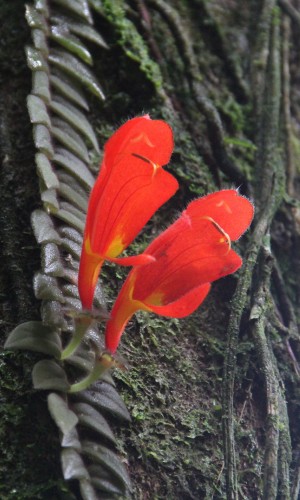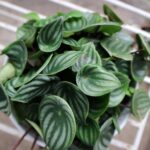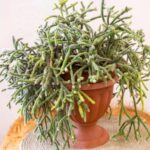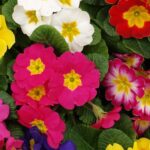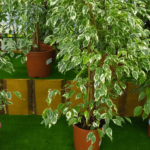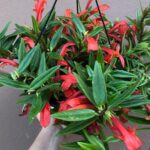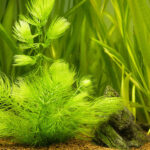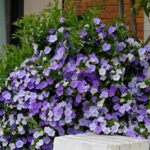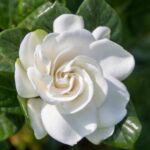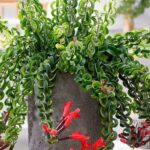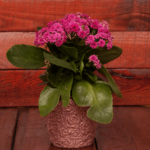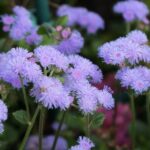The Goldfish plant (scientific name: Columnea gloriosa) is a plant native to Central America, mainly found in Costa Rica.
In its natural habitat, this plant grows in warm and humid places, hanging on tree trunks (epiphyte).
Continue reading, as, in this article, you will see photos of this plant, learn its characteristics, and, most importantly, how to cultivate it correctly.
Plant Characteristics
The leaves of the Goldfish plant are easy to identify.
They are thick, have a velvety texture, and a grayish color.
Moreover, there are different varieties of this plant, so you can easily find leaves of other colors, including green and even reddish.
Reaching up to 90cm (35,4 inches) in height, the Goldfish plant is known abroad as the Goldfish plant, due to the appearance of its flowers.
The flowers appear between spring and autumn, emerging along the branches of the plant, solitary and with a tubular and curved shape.
Their color is usually reddish with a yellow part in the throat, hence the nickname Goldfish.
An interesting detail is that these flowers have a velvety texture on the outside and are yellow on the inside.
Also, they have an intense shine, with vibrant red and yellow details.
These plants are pollinated by hummingbirds, so if you cultivate them, you may see hummingbirds in your garden.
Other Curiosities
- If well cared for, you can see your Goldfish plant living for more than 10 years.
- During my research, I found sources mentioning that this plant is poisonous, while others stated that it is not poisonous. Unfortunately, I do not have definitive information on the subject, so I recommend keeping it away from children or animals.
- The plant genus Columnea has more than 200 species; its name was given in homage to the botanist Fabio Colonna in the 16th century.
- In addition to this plant, there are also others commonly called “Goldfish Plant,” for example, the species Nematanthus gregarious.
Now that you have learned about the main characteristics of this plant, see below how to cultivate it correctly.
How to Care for the Goldfish plant
If you live in tropical regions, where the climate is warmer and more humid, cultivating the Goldfish plant will probably be an easy task for you.
Now, if you live in colder environments, more care will be needed to keep it healthy.
Below, I will explain in a simple and detailed way how you can take care of this plant correctly.
1) Where to Place It
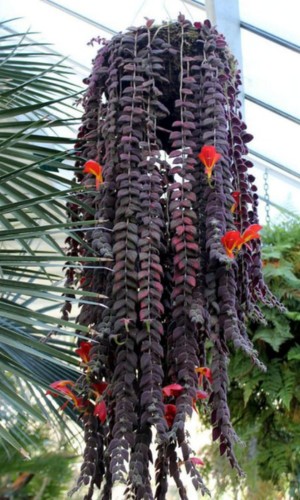
The Goldfish plant is a very versatile plant, being able to be cultivated in various places. Below are the most common ones:
- Hanging baskets or pots
- Attached to trees
- Used as ground cover in gardens
Its cultivation can occur indoors or outdoors, with the most important thing being that you provide the ideal climate for its development.
2) Ideal Temperature
As mentioned before, this is a plant that prefers warmer environments.
Try to keep your Goldfish plant between temperatures ranging from 18°C to 24°C (64°F to 75°F). In places where frosts or very low temperatures are common, it is usually recommended to cultivate this Columnea indoors.
See more:
- Columnea: Varieties, How to Care and Make Seedlings
- Lipstick Plant – How to Care, Prune and Fertilize
- Twister Lipstick Plant – Characteristics and How to Care
3) Humidity
Humidity should be high. Low humidity can cause leaf drop.
If you live in a very dry environment, it may be necessary to use a humidifier or a tray with pebbles and water.
Another option, during the driest months, you can spray water on the leaves of your Columnea.
In this case, remember to do this when the sun is weak.
4) Ventilation and Lighting
Ventilation is a very simple factor to provide for your Goldfish plant; just make sure it is in a well-ventilated place, but avoid strong winds.
As for lighting, this is a plant that loves indirect sunlight.
Avoid direct sunlight on it, especially during the hottest times of the day, as this can burn its leaves and hinder its development.
5) How to Water
This Columnea needs you to follow the same rule used in the cultivation of various species of ferns, indian lettuce, and even ageratum.
- The soil must be kept moist through regular watering, but be careful not to waterlog the soil.
- Water in the early morning or late afternoon.
- In warmer months, watering frequency increases; in colder months, it decreases.
Excess watering will rot the roots and stem of your plant.
6) How to Fertilize
Proper fertilization will help your plant grow and bloom.
To do this, we recommend using a phosphorus-rich fertilizer; two recommendations are:
- NPK 10-30-10
- NPK 04-14-08
Apply it during spring, summer, and autumn. Regarding frequency and quantity, I recommend following what is stated on your fertilizer’s packaging.
Fertilization also follows the same logic as watering; you should do it in the coolest times of the day, that is, early morning or late afternoon.
7) Pruning and Repotting
Pruning will help your plant develop better, and in the case of the Goldfish plant, it will occur on two occasions:
- After flowering
- During repotting
After flowering, you will prune the stems.
In this procedure, you will prune the stems that are starting to get too long. It is recommended to keep them between 30 to 45cm (12 to 18 inches).
Repotting should occur when you notice that the roots of your Columnea are starting to come out of the pot. This usually happens every 2 or 3 years.
During the repotting process, you can take the opportunity to prune old or dead roots. The ideal soil for this plant should be rich in organic material and provide good drainage.
How to Multiply the Goldfish plant
Multiplication can be done by 3 means.
- Stem cuttings: during spring or summer, choose a healthy stem that is not flowering, cut it with a minimum length of 7cm (2,75 inches) using sterilized scissors. Leave only the leaves at the tip of the stem. Plant it in soil with plenty of organic material, and if you want, use a rooting hormone. See more about this procedure here.
- Division of the plant: during repotting, you will divide your plant. Be careful not to divide it into too small parts.
- Seeds: it is the most complicated method. Plant the seeds, put a plastic bag around the pot to maintain humidity, ensure that the pot receives plenty of sunlight throughout the day, and stays at ideal temperatures for this plant (already mentioned in the article). Germination occurs after about 2 weeks.
Conclusion
The Goldfish plant is a great choice to grow in your home or garden.
I hope that by following the tips above, you can keep your plant healthy and energized to bloom every year.
Oh, and remember that this plant can be susceptible to attacks by mites, scales, and aphids. Therefore, from time to time, in addition to following the tips in this article, also monitor your plant.
Did you like this article? Then share it on your social networks and also leave a comment below. I will be very happy to respond.


